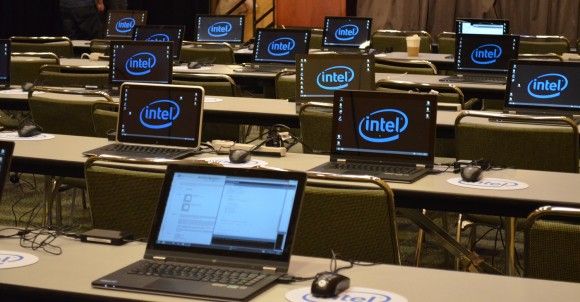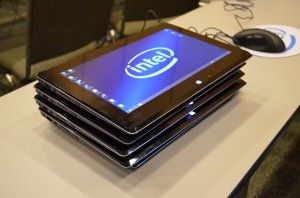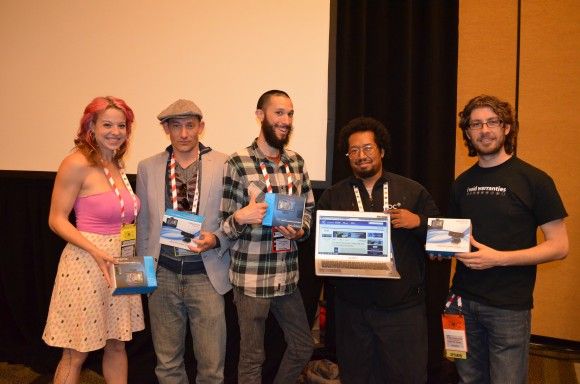At GDC 2013 yesterday, Intel held a day-long developer session focused on what they call ‘perceptual computing’ — interacting with computers in more natural ways, thanks to advanced sensors. They brought with them a heap of Ultrabooks, each with a different design, to allow a room full of developers the opportunity to get hands-on experience with many facets of perceptual computing and the Ultrabook hardware itself. Additionally, Intel sent attendees of the session home with their custom Kinect-like depth camera.
Intel came well prepared with an array of Ultrabooks. The Asus TaiChi 21, Dell XPS 13, and Lenovo Yoga 13 were all present in vast numbers. Each includes a touchscreen and convertible functionality to change from a laptop to a tablet. The TaiChi 21 has dual-screens (one on the front of the lid and one on the back), the Dell XPS 13’s screen spins around in its bezel, and the aptly named Lenovo Yoga 13 has a screen that folds all the way back on itself.
The Ultrabooks allowed a room full of developers to start working with Intel’s Perceptual Computing SDK which last week dropped its beta tag and is now officially launched.
The Perceptual Computing SDK is freely available from Intel to anyone. It provides close-range hand and finger tracking, speech recognition, face analysis, and augmented reality functions to help developers get started on next-gen apps for Windows 8 and Ultrabooks. The SDK supports 2nd- (Sandy Bridge), 3rd- (Ivy Bridge), and 4th- (upcoming Haswell) generation processors from Intel.
Enabling the functions of the SDK is the Interactive Gesture Camera which was developed in partnership between Intel and Creative. The Gesture Camera is a miniature Kinect-like device loaded with sensors to allow developers to create more intuitive means of interacting with computers. The Gesture Camera is only available from Intel and can be purchased from their site for $150.
Intel expects that sensors provided by the Gesture Camera will soon be built into the bezel of Ultrabooks, allowing for perceptual computing on-the-go without any additional peripherals. The Gesture Camera and Perceptual Computing SDK allows developers to get started with perceptual computing apps so that when that time comes, there will be exciting experiences available for Ultrabook owners.
Yesterday, Intel handed out some 150 (or $22,500 worth) of Gesture Cameras to developers who attended their day-long dev session, called ‘Natural, Intuitive, and Immersive Gaming’ at GDC 2013. Intel is clearly excited about where the SDK will take natural human-computer interaction. They say that in 2013 they’ll be giving out $1 million to developers doing cool stuff with perceptual computing.
Disclosure: Intel is sponsoring Ultrabook News’ coverage of GDC as part of our involvement in their Ultimate Coder Challenge, in which our own Chippy is a judge of several teams which are competing to make perceptual computing applications.














Does Microsoft help fund these things? Seems like Intel is only focusing on Windows development or do they also provide development tools and drivers for Linux targeted software?
It would actually be nice to make use of some of the required hardware features of ultrabooks with a Linux OS for some applications.
It’s unlikely that MS helps fund them but they and Intel are very close.
Have you seen the XPS 13 Developer Edition with Ubuntu?
http://ultrabooknews.com/2012/12/03/dell-launches-xps-13-developer-edition-ultrabook-with-ubuntu-pre-installed/
That’s for web development. It’s not really the same as what Intel is promoting. Intel is trying to get devs to develop native software that makes use of the required hardware for gesture control, use of location, orientation info and all the other stuff you mentioned in your post.
I guess you meant XPS 12?
Because the XPS 13 is a nice Ultrabook but nothing extraordinary and no screen spinning around iin its bezel.
I am wondering why Intel omitted Surface Pro from the sortiment. Do they consider Kinect as a competitor? It woul be sad.
Doesn’t matter. Until they provide a modern device for a $500-$599 price point nothing they do matters.
Fast boot times, super thin and light and long battery, and touch screen for $599 that’s all that matters. x86 app compat to provide something extra and compelling.
IT’S THE PRICE, STUPID! INTEL’s screwed and Windows, too if Intel doesn’t let the profit margin drop. (They need to unchain Atom or make Core CPUs WAY cheaper.)
Adam
Every device that exists today is a downgrade from 18 – 24 months ago in terms of price. Why the hell a prices in the thin and light and long battery life space INCREASING while competition from cheap tablets is obliterating PC sales?
IT’S THE PRICE, STUPID!
There are many things that affect the price of a device. Research and development of putting a Core i and other chips in a thin space without causing a lot of overheating. The associated costs of a Core i is more than an Atom or ARM chip. Windows requires a license although OEMs try to offset this by adding bloatware. The faster SSDs and WiFi chips cost more than the eMMC and SDIO based WiFi chips put into iOS and Android tablets. There may be other chips in a notebook that tablet don’t have like Ethernet controllers.
If they priced these at $599 they’ll make negative profit so they might as well not make them at all which definitely won’t be good for the people who want to buy them. Otherwise at $599, you’ll get thicker, overheating, cheaply made, bad case materials, etc.
There are plenty of other things that make these thin notebooks cost more than iOS and Android tablets just at the cost to the manufacturer level. All companies involved are trying to make things cost less for them but that’s just how it is right now.
A “normal” laptop cost around 500-600$ fully equipped with an i7.
An ultrabook goes for twice that price. You seem to forget that Intel is fixing the price on all ultrabooks components.
A slim ssd is way cheaper nowadays than it was a year ago, yet the ssd sold in those ultrabooks just climbs off the chart every year.